Creating a Framework for Client Success
Creating a Framework for Client Success
Starting a client relationship on the right foot isn't just good practice; it's essential for long-term success. The initial interactions establish the tone and framework for what follows. This is where trust begins, and the path for collaboration is set.
At this stage in the journey, we are less concerned with the marketing numbers and more concerned with the big picture. What does the client want to achieve, and–most importantly–why?
James Londesborough, Owner, Ignite Marketing
To optimize those early days, your agency must prioritize clear communication, understand your client’s needs, and seek out the right tools to track the data as it rolls in. Developing a solid onboarding strategy that hits each of these notes will lead to greater harmony.
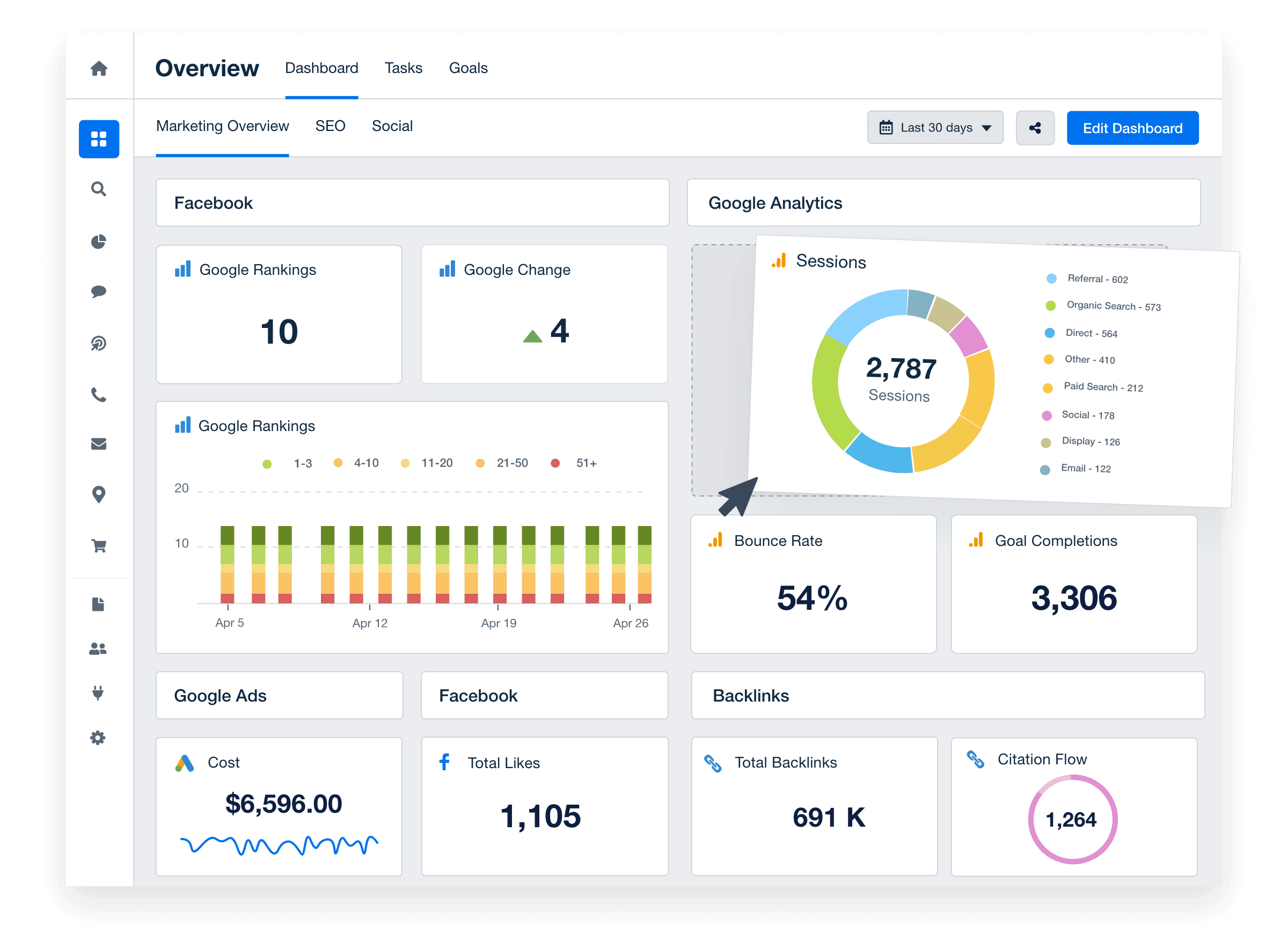
A solid onboarding protocol ensures internal efficiency, reduces the amount of follow-up, and shows the client you are organized and competent, increasing their trust and building rapport.
Will Goldfarb, CEO, Merkava Group
The more you and your clients understand each other from the get-go, the less time you'll spend on misunderstandings and better be able to achieve your mutual goals. It's not rocket science; it's just good relationship hygiene.
In this chapter, we’re exploring the best practices that will help you set your clients up for success from day one.
Understanding Client Needs and Goals
An understanding of your client's needs and goals is the compass that guides every strategy, decision, and action within your agency. It's not just about ticking off a checklist; it's about establishing a shared vision that forms the basis for a long-lasting partnership.
It's very important for an agency to understand the client's goals and objectives, create a proper marketing strategy, and set proper expectations for the results, reporting, and communication.
Anatoly Zadorozhnyy, CEO, Marketing1on1
Failure to thoroughly grasp your client's objectives leads to a number of negative outcomes:
Eroding Trust and Confidence: Lack of understanding quickly erodes a client’s trust. You may deliver a project on time and within budget, but the trust factor takes a hit if it doesn’t align with what the client truly needs or expects.
Resource Drain: When goals are misaligned, the chances of having to revise or redo work increase significantly. This requires additional time and consumes resources that could be better used elsewhere.
Financial Costs: Misunderstanding objectives can be expensive. In worst-case scenarios, it may even lead to contract termination and loss of the client, which also means incurring costs to acquire new clients.
Team Morale and Productivity: Consistently failing to meet client objectives demoralizes your team. The resulting work environment becomes less conducive to creativity and excellence, hampering future projects.
Negative Reputation: In today's interconnected world, word travels fast. Poor client reviews significantly damage your agency's reputation, affecting your ability to attract new clients and retain existing ones.
Legal Implications: While not common, failure to meet client objectives could sometimes have legal consequences, particularly if there's a discrepancy between the deliverables and what was agreed upon in the contract.
Understanding a client's goals is critical for successfully delivering a project. Failing to invest the time and resources to get this right presents a potentially dangerous oversight with immediate and long-term consequences.
Techniques for Gathering Client Requirements
To avoid the problems that come with misunderstanding your client, proactive steps must be taken from the start.
We set realistic goals through collaboration, looking at their industry, target audience, and specific business objectives. Lastly, we consistently report and communicate regularly to provide data-driven insights and performance metrics to demonstrate the effectiveness of our strategies.
Steph Busia, Account Manager, Moxie Tonic, LLC
Here are some techniques that can help:
Initial Meetings: Before diving into the project, arrange a meeting—virtual or face-to-face—to discuss expectations, requirements, and goals.
Questionnaires: Distribute tailored client onboarding questionnaires to your clients that tease out specifics about their industry, audience, and objectives.
SWOT Analysis: Conduct a SWOT (Strengths, Weaknesses, Opportunities, Threats) analysis for the client. This exercise helps reveal what the client explicitly says and what might be areas of concern.
Establish MASTER Goals: Collaborate with the client to define MASTER goals, which are Measurable, Achievable, Specific, Transforming, Evolving, and Relevant. This method offers a nuanced and adaptable framework for aligning agency deliverables with current client needs.
Ongoing Communication: The initial gathering of requirements is not a one-and-done task. Keep lines of communication open and regular. Monthly or quarterly reviews will ensure you remain on the same page.
The onboarding questionnaire is a great way to reconfirm strategy, main areas of focus, and give the client a thorough run-through of the next steps and expectations. It’s a great tool to make sure everyone is on the same page from the start of the campaign.
Scott McCluskey, Digital Marketing Manager, Pivotal Agency
Download Your Client Onboarding Questionnaire Template
Streamline your workflows and grow your agency.
Importance of Aligning Client Goals With Agency Capabilities
It's essential to remember that understanding is a two-way street. Just as you need to understand your client's business, they need to understand yours. Always be upfront about what your agency can and cannot do.
Not every client is a good fit, and that's okay. Transparency in capabilities ensures that expectations are set right from the start, avoiding disappointment down the line. If the client's goals are significantly misaligned with your expertise and capabilities, it may benefit both parties to part ways early in the relationship.
You do your best work when you have a strong relationship with your client. Don't sacrifice that for someone who isn't the right fit for you and your business. In my experience, each time I've made this call, it's opened up room for a new opportunity with an ideal client.
Brittany Woitas, Founder, Kōvly Studio
Gaining alignment on goals is continuous and critical. Failure to engage in this essential dialogue is like setting sail without a map or compass—you may eventually get somewhere, but it's unlikely to be the destination you wanted.
Creating Streamlined Client Onboarding Processes
The onboarding process sets the tone for your entire client relationship. It's like a first impression; you only get one shot to do it right.
This is where it all begins. The client has signed the contract, and it's time to deliver. How you handle onboarding can make or break your entire client relationship.
This is when the client is most attentive, expectations are formed, and critical information is exchanged. Streamlining onboarding using repeatable processes makes this phase more efficient and more effective.
When we're onboarding new clients, there's a huge checklist of tasks to go through: getting access to or creating ad accounts, websites, Google Analytics properties, Google Search Console, and more, formulating a strategy, setting up conversion and event tracking, etc. You know the drill. It's a tedious and lengthy process. With AgencyAnalytics, the step for implementing reporting is a snap. Because you can create reports with just a few clicks, that whole process is effortless and anyone on the team can do it.
Graham Lumley, Director of Growth Marketing, Blackhawk
Common Bottlenecks in Client Onboarding and How To Avoid Them
A smooth onboarding process is a marketer's dream, but several bottlenecks often transform that dream into a nightmarish ordeal.
Getting new clients is great, but as we grow, onboarding can be so time-consuming.
Linda Rooney, Founder + CEO, DandeLions Digital
Let's identify some of these common culprits:
Information Overload: With so much information to share and obtain, it's easy to lose track. Systematized processes help you gather only what's essential and cut down on the clutter.
Time Delays: Whether it's waiting on client-provided data or internal approvals, delays dampen enthusiasm quickly. Pre-defined timelines within your onboarding flow keep everyone on track.
Unclear Responsibilities: It’s easy for tasks to fall through the cracks when it's unclear who's responsible for what. Clear onboarding processes outline responsibilities upfront.
Setting Expectations During the Onboarding Process
Clear expectations are the foundation of client satisfaction. Set realistic timelines, deliverables, and performance metrics during onboarding.
For instance, if the client expects a 20% increase in organic traffic, outline the steps to achieve this and a realistic timeframe—like six months—to meet that target. Using a task management tool helps clarify what tasks will be completed weekly, monthly, or quarterly. It’s also important to set an expectation for the reporting cadence, whether that be weekly, monthly, or via live dashboards. Transparency upfront saves you a headache later.
When we're onboarding a client, we ask what their KPIs are, then we ask them to help us connect their accounts to our system. We show them what we're going to track, how we're going to track it, and what they can expect.
Ruben Roel, President, Investigator Marketing
In addition to the initial setup, consider implementing a 30-60-90 day review within the onboarding process. This will serve as a built-in mechanism to revisit initial expectations.
Let's say you projected a 10% increase in social media engagement in the first 30 days. When that mark is hit, it’s not just a win; it’s a trust-builder that validates the client's decision to work with you. Regular check-ins like these prevent misalignments and build a framework for long-term success.
Incorporating a Reporting Tool From Day One
When laying the foundation for successful client relationships, selecting the appropriate reporting tool is like choosing the right tool for a surgical procedure—it's mission-critical.
Manual reporting has its merits, especially for early-stage agencies where every client relationship is hands-on and the client list is short. However, as your agency scales, manual reporting becomes less of a quaint, personalized touch and more of a logistical nightmare.
We keep growing and our reporting needs to grow with us. With automated reporting, all of our customers can enjoy high-quality reports.
Nico de Jong, CEO, Forward Marketing
Think about it: more clients means more data, and more data means longer hours spent compiling reports instead of strategizing and executing campaigns. It's like trying to fill a swimming pool with a teaspoon—inefficient and not sustainable in the long run.
In contrast, a report automation tool streamlines this process, making it possible to manage a growing portfolio of clients without compromising quality or attention to detail.
With the right reporting tool built into your onboarding process, your team starts reporting on goals and results immediately, reassuring the client that your team will deliver the ROI you’ve promised.
Let’s take a closer look at how to incorporate reporting into your onboarding tasks, and how to choose the right platform to suit your needs.
The Role of Reporting Tools in Client Communications
Effective client communication is not just about sending "Hey, how are you?" emails. It's about delivering valuable information in a digestible format.
A reporting tool does more than just compile data; it helps you tell a story the agency and clients understand.
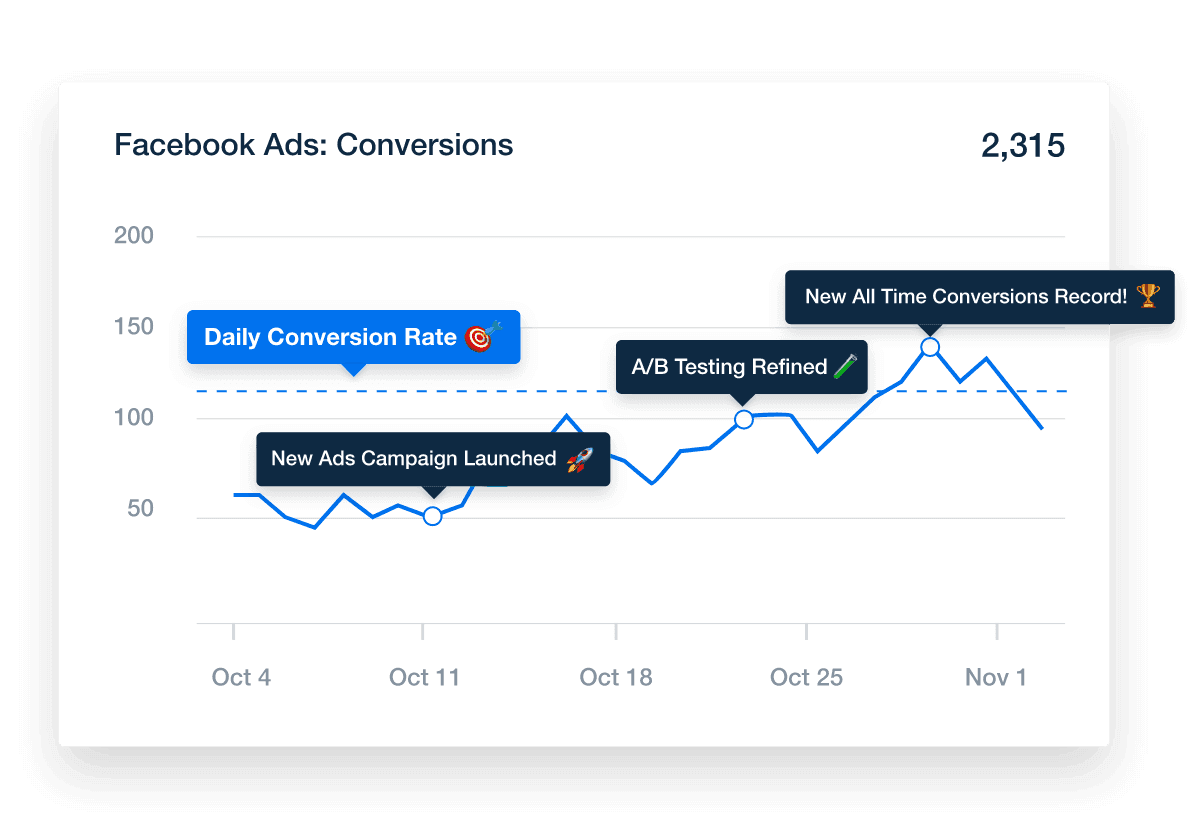
This narrative revolves around performance metrics, objectives achieved, and areas for improvement, ensuring the client not only hears but comprehends your agency's impact.
Incorporating reporting early in your relationship also allows your agency to set dynamic goals, and maintain consistent communication with the client about your progress towards achieving them.
Dynamic goals allow clients to see changes as they happen. For example, if you promised a 15% increase in monthly website traffic, don't wait for the end-of-month report to show progress. Update your report template to reflect real-time analytics. When the client sees that you've hit or exceeded that 15% halfway through the month, it’s more evidence of your agency’s efficacy.
We sell SEO and PPC services, but our clients don't care about how they work, they care about calls and their bottom line. I can show them beautiful numbers, traffic patterns, increases in rankings, etc. But at the end of the day, they're paying us for a service to increase their revenue.
Ruben Roel, President, Investigator Marketing
Incorporating dynamic goals helps make room for agile adjustments. If a goal isn't being met, both parties see it in real time and take corrective action before it becomes a more significant issue. This proactive approach demonstrates a commitment to continuous improvement and problem-solving, which clients love.
Finally, dynamic goals contribute to a sense of momentum. Celebrating early wins encourages a culture of achievement and sets a positive tone for future work. It keeps everyone engaged and excited for what comes next, from the agency team to the client stakeholders.
Benefits of Creating Campaign and Account-Level Templates To Speed Up Client Onboarding
Before diving into the benefits, let's get something straight: templates are not about cutting corners but enhancing efficiency and client satisfaction.
We start with a template for our new clients, and during their onboarding, we ask what their top KPIs are. We make sure to include those on the first page for them. As we have our first few strategy meetings, we take a look at these reports and ask our clients about their reports, and make edits to the templates with our clients as another customization tool.
Christina Cypher, Director of Marketing, Click Control Marketing
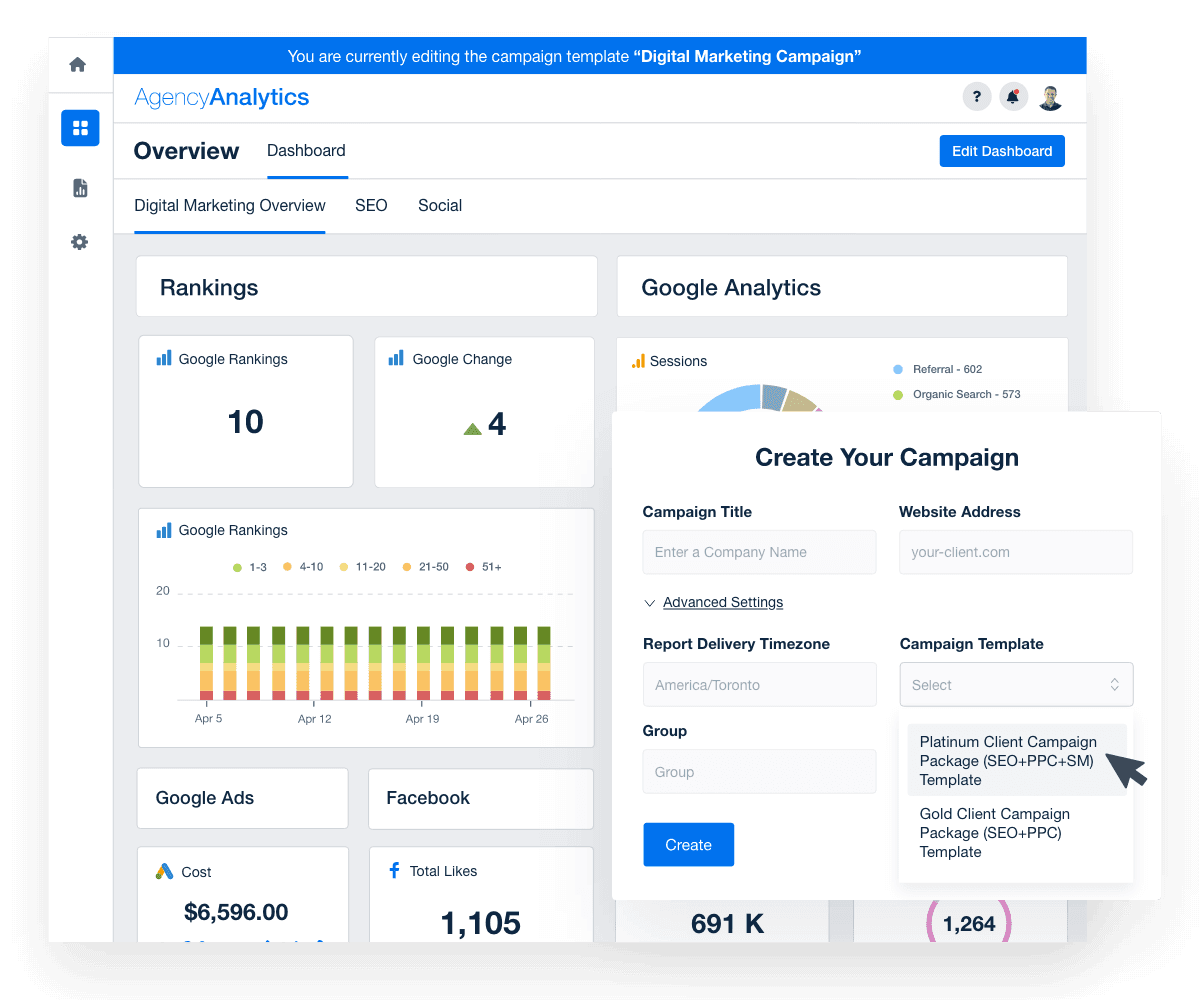
Here are some compelling reasons to integrate campaign and account-level templates into your onboarding strategy:
Consistency: A template standardizes the onboarding process, ensuring every client gets the same high level of attention and service.
Efficiency: You save time when you don't have to reinvent the wheel for every new client. And time is money, right?
Quality Control: When you use a template refined over multiple client interactions, you're using a tool you know works well.
Tailored Experience: While templates standardize the process, they also leave room for customization, allowing you to adapt to each client's unique needs.
Risk Mitigation: A structured reporting process reduces the chance of mistakes or omissions that could compromise the client relationship.
Create a master report template that lays out the specific metrics you want to report on for each type of campaign/instance first and foremost so your reporting is uniform across clients. This also saves your agency time because you aren't starting from zero each time.
Molly Lopez, Owner-Partner, Sparo Marketing

Report and dashboard templates aren’t just about making your life easier; they're about elevating the client experience by providing consistent communication and ongoing proof of your agency’s results.
Templates are a lifesaver because you can just duplicate them for each new client you get, so you don't have to make a whole new dashboard and report each time.
Mikael Sørensen, Head of Marketing, Adtention
Key Considerations When Selecting a Platform
Selecting a reporting platform requires careful thought—your agency's unique needs dictate the best choice. Consider multiple factors to make an informed decision.
User Experience: The platform should be intuitive and user-friendly for agency and client users.
Customization: The ability to tailor reports to each client's needs is a game-changer. Your clients are unique; your reports should be, too.
Scalability: As your client roster grows, your platform should keep pace. Check if the platform can accommodate a growing number of clients without a hitch.
Integrations: The platform should seamlessly integrate with other tools and software your agency uses. It's 2023—data silos should be a thing of the past.
Customer Support: Don't underestimate the value of responsive and helpful customer support. A platform with excellent customer support helps you resolve issues quickly and ensures a smooth user experience.
Ongoing Improvements: A static tool is a stagnating tool. Opt for a platform that continually updates and adds new features to stay ahead of industry trends.
Choosing the right reporting tool is crucial when setting the stage for a fruitful client relationship. And if you’re looking for a platform that ticks all the right boxes, it’s hard to ignore what AgencyAnalytics brings to the table.
Report Smarter, Not Harder.
Better, Faster & Easier Client Reports Are Just a Few Clicks Away
Start Your Free Trial TodaySecurity Considerations in Client Reporting
The integrity of your agency depends on your ability to handle sensitive client data responsibly. The fundamentals of data security in client relations and the importance of setting user permissions to control data access should not be ignored.
Setting User Permissions To Control Data Access
Controlling who has access to what is as important as the protective measures surrounding the data. User permissions should be strictly defined based on roles within the agency and the client's specific needs.
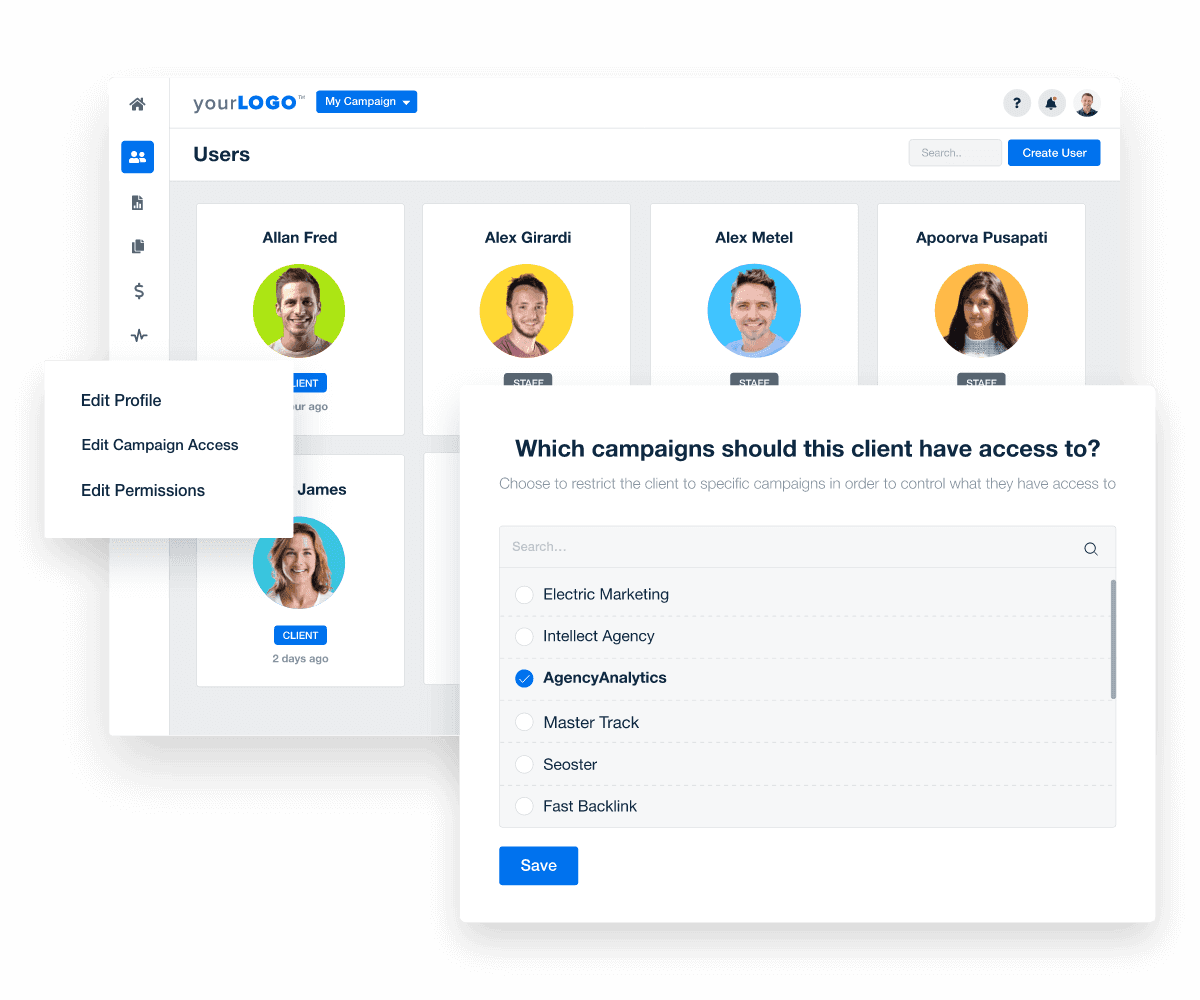
For instance, team members not involved in data analysis should not have access to sensitive analytics data. On the client's end, only the designated client-side team members should have permission to view or modify specific reports.
We want to be totally transparent with our clients, and AgencyAnalytics allows us to provide our clients with a live dashboard where they can have full insight into what we're doing without needing to give full access to the ad platforms where they would have the potential to interfere with performance.
Michael Wisby, CEO, Two Trees PPC
These permissions are set at a granular level and allow you to specify who can view and edit reports. It's best practice to regularly review and update permissions, especially when there are staff changes either in your agency or on the client’s team.
By securing client data and controlling its accessibility, you protect your agency and clients and solidify the trust upon which long-term relationships are built.

How TDMC Uses Time Saved to Better Understand Clients' Needs
TDMC, or The Digital Media Collective, started as a one-woman operation in 2013 founded by Cheryl Ingram. Fast-forward a few years, and the company has blossomed into a 46-person agency focusing on ecommerce.
Problem: Reporting Challenges They Faced
As TDMC rapidly expanded, it ran into a severe bottleneck: reporting. The agency was using a mix of different reporting platforms along with manual PowerPoint presentations to keep their growing list of clients informed. Cheryl Ingram and her team found they were spending way too much time compiling data, which hampered their ability to focus on their clients' needs.
Solution: How they Overhauled Their Client Reporting Process
Cheryl knew the hours lost to manual reporting could be better spent on client interactions. Enter AgencyAnalytics, a platform that streamlines automation of the reporting process. The platform's seamless integration with Shopify made it a no-brainer for an agency deeply embedded in the ecommerce sector.
Outcome: Impact on Client Relationships and Agency Growth
Once TDMC shifted to automated reporting, the benefits were instant. Reports were ready in the first week of each month and appeared more polished and reflective of the agency's brand identity. The efficiency gains were channeled into improved client communication and new client onboarding, helping TDMC continue its upward trajectory.
Lessons: Takeaways That Can Be Applied by Other Agencies
Cheryl's advice for other agencies in a similar bind is simple but impactful. Automate your reporting where possible and keep it to the point. Don't bury clients under a mountain of data—focus on metrics that answer the "so what?" question. And always, always make sure you use the time saved to better understand and meet your clients' needs.
After trying multiple reporting platforms that were good, but just not good enough, we chose AgencyAnalytics because it ticks almost every box we need it to.

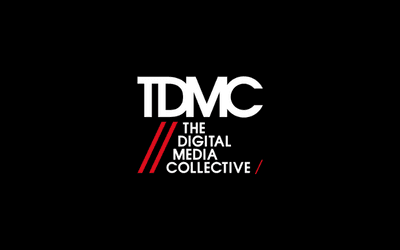
Importance of Timely and Consistent Reporting in Relationship Success
In a client-agency partnership, the value of timely and consistent reporting is often underestimated. After all, clients invest money and time in your services and want tangible, reliable evidence that their investment is paying off. Timeliness and consistency in reporting are non-negotiable for a successful relationship. They forge a clear connection between your agency’s efforts and the client’s results.
The onboarding phase is the perfect time to establish the right reporting cadence to meet the client’s needs. Let’s take a closer look at why timing matters.
The Relationship Between Report Timing and Client Trust
Timely reporting isn't about beating the clock but demonstrating accountability and professionalism. When reports arrive like clockwork, clients are less likely to question the effectiveness and reliability of your services. Timely and consistent reports help create stable, long-term relationships.
On the flip side, tardy or sporadic reporting can stir up unease. For instance, if a client expects to see a weekly performance report every Monday and it arrives late—or worse, not at all—that’s a trust-eroding moment. Timely reports also allow for more agile decision-making. If there's a red flag in the data, quick detection gives you and the client more time to respond and course-correct.
As an agency, it's sometimes frustrating how much time you need to spend showing clients that you're doing actual valuable work, especially in digital marketing, where so much happens behind the scenes. AgencyAnalytics helps us prove our worth with polished reports and easy-to-understand data that shows our value.
Brendan Chard, Owner, The Modern Firm, LLC
Guidelines for Setting up a Consistent Reporting Schedule
Setting a reporting schedule starts with understanding client needs. Some clients might need quick weekly updates, while others may favor a comprehensive monthly review.
Here are some steps to tailor a reporting schedule to meet client needs effectively:
Discuss Frequency: The first thing to establish is how often the client wants to receive reports. Some may opt for weekly reports. Others may prefer monthly or even quarterly updates. In the recent Marketing Agency Benchmarks survey, 58% of the agencies surveyed stated that they lean heavily on monthly reports.
Type of Data: Different frequencies may require different types of data. A weekly report might focus on immediate KPIs like engagement metrics, while a monthly report could dive into ROI, long-term goals, and key strategic wins.
Time of Delivery: Setting a specific day and time for report delivery is critical. This will vary depending on the client’s time zone and work schedule. Hint: Tuesday between 9-9:30 a.m. appears to be the best time to send a client report, based on data from the over 6,500 agencies currently using AgencyAnalytics.
Automated Reminders: Use technology to your advantage. Tools like AgencyAnalytics automatically schedule reports and ensure they go out at the same time every cycle.

It’s essential to keep in mind that a reporting schedule shouldn’t be set in stone. As the client's needs change, revisiting the reporting schedule and adjusting as needed is advisable.
AgencyAnalytics plays a pivotal role in streamlining client onboarding and reporting processes, which serves as the bedrock for a long-term, fruitful partnership between agencies and clients.
With features like customizable templates, automated reporting schedules, and robust security measures, the platform eliminates many of the hurdles agencies face. Its user-friendly interface and actionable insights make it easier to engage clients, fulfill their specific needs, and earn their lasting trust.
In short, AgencyAnalytics is not just a tool but a strategic asset that elevates the professionalism and efficiency of your agency, and positions you for growth and long-term client retention.
Get Started for Free
